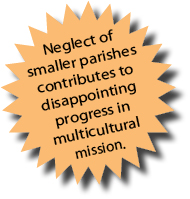![]()
 As we noted in our latest Social Media post, finding the time for social media is the biggest hurdle for churches in acclimating to the digital world.
As we noted in our latest Social Media post, finding the time for social media is the biggest hurdle for churches in acclimating to the digital world.
“Church” has been done the same way for centuries. People entering ministry have expectations for how they will spend their time when they are called to a parish. Something like this: Monday will be spent on office housekeeping and reflection in preparation for next week’s sermon. Parish calls are made on Tuesdays and Thursdays. Wednesday is bulletin day and Bible study, choir practice or some other group activity. A few hours of Thursday might be spent with colleagues over lunch. Meetings will be scattered throughout the week. Friday is for polishing the sermon. There are always emergencies. And one of these days is a day off.
Time must be found. Social Media is simply too powerful to ignore. If you are serving an aging congregation it is all the more vital. Your older members may be willing to forego it, but the current coming-of-age generation — Generation Y — lives with their cell phones epoxied to their palms. If you want your church to have a future, you MUST speak the language and use the tools of the future.
How do you make the time?
There is no doubt it will be hard to adjust the routine. It is an adjustment for everyone! We suggest a two-pronged approach:
- Set aside 30 minutes a day for social media. Start your day with it. End your day with it or follow your lunch break with it. Make it a routine.
- Let others help.
Carving out a half-hour may be the easiest of the two steps to take, especially after you begin to see results. In our experience that took six months of daily posting to grow readership to our current average of 50 readers a day and a thousand each month. Warning: A half hour is a start. You will find Social Media so compelling that it will become more vital to your church community.
The second part — letting others help — is a major shift in church structure but it is going to happen. Top-down church leadership is quickly becoming a thing of the past. If people do not have a voice in their churches they will fill their lives with things that engage them.
This adds a new church emphasis for which your social media can be a tool. Education. You want members engaging in online religious issues to be knowledgeable. Many churches have neglected education. Use Social Media to break that cycle. We’ll address this in our next Social Media post.




